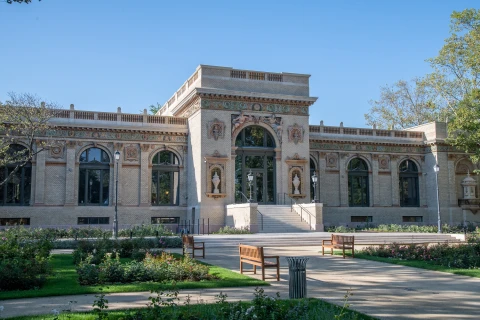

House of the Hungarian Millennium I NEO Contemporary Art Space
One of the Városliget's most beautiful buildings, the former Olof Palme House, has been renovated. Among the oldest structures in the park and formerly a venue for the "Hungarian millennium" exhibition, the building was opened to the public in October, 2019 thanks to the Liget Budapest Project. The house has been restored with a focus on tradition but in accordance with the standards of the 21st century, with the exhibition NEO Contemporary Art Space, and a cosy Zsolnay Cafe, evoking the mood of the turn of 20th century.
Designed by Ferenc Pfaff, the structure was built as an arts hall for the 1885 National General Exhibition, and the critics of the day felt that it was one of the most beautiful elements of the event thanks to the unique Zsolnay decorations. However, the house almost immediately proved inadequate for exhibitions, so the significantly larger Hall of Art was built a few years later and still operates today. The house later functioned as the Budapest Museum, but it was damaged during World War II and the original interior décor was destroyed. With the establishment of the Art Foundation in the 1950s, the building was used as a sculptors' studio, before the Fine Art Production Company later moved its headquarters here and later came under the ownership of the Hungarian Creative Art Public Endowment, but a suitable artistic or cultural function was never found for it.
The restoration begun in late 2017 is taking place according to the original architectural blueprints, returning the building's imposing spaces to their former glory.

The main entrance returned to the original Hermina Street side, in front of which a new rose garden was created as part of the park's new landscaping. The building's subsequent additions have been removed, while the building has been returned to its original structure. The construction of a new roof clad in huge glass surfaces and the restoration of the remarkable Zsolnay ceramics decorating the building's facade have also been completed. With a 1250-square-metre footprint, the building renewed as a cultural community space boasting an exhibition area and a restaurant/café evoking the atmosphere of the late 19th century and the "Hungarian millennium", with the lowest level housing a small auditorium and conference room, as well as a space for museum pedagogy.
The reconstruction of the building in keeping with its status as a cultural monument is finished, and the building welcome visitors under its new name of Millennium House from October, 2019. Through the Liget Budapest Project, architectural additions made subsequently to the building's original inauguration have been removed, the original structural framework has been restored, the new roofing has been covered with expansive glass surfaces, and the remarkable Zsolnay ceramics ornamenting the edifice's facade have been restored.
Following the comprehensive rehabilitation of the park and its institutional network, the House of the Hungarian Millennium will become one of the gems of the Városliget. It is also a symbol of the goals of Liget Budapest as its concept not only preserves tradition and reinforces links between the park and art, it also turns one of the Városliget's oldest buildings into a genuine community space and activity centre.
The mission of the NEO Contemporary Art Space is to become an exhibition space for the world’s foremost contemporary fine artists in Budapest’s City Park. In search of an international parallel, it is perhaps the Serpentine Gallery in London’s Kensington Gardens park, whose mission is the closest to that embraced by NEO in regard to location, appearance and function alike.
NEO operates within the organisational framework of the Városliget Zrt. and under the professional mentoring of the Museum of Fine Arts Budapest. Together with the Museum of Fine Arts, the Műcsarnok/Kunsthalle and the New National Gallery (to be built in the near future), NEO is an important element with a special mission in the unique and colourful fine art complex of institutions embedded in the City Park.
The 350-square-metre exhibition space in the Millennium House provides the opportunity to present a wide spectrum of contemporary works and installations. It is among the objectives of NEO to build active professional cooperation with higher education institutions of art. In addition, the art space places major emphasis on the educational dissemination of the arts; in order to realise this, it organises guided tours and museum education workshops for all age groups.